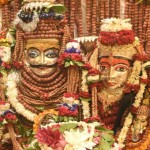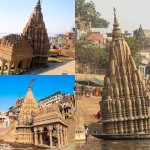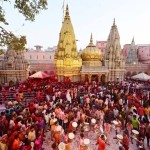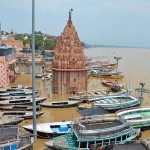The Kashi Vishwanath Temple, located in the ancient city of Varanasi, is one of the most revered temples in India, dedicated to Lord Shiva. The temple holds an exceptional place in the hearts of millions of devotees who flock to this sacred site to seek the blessings of "Baba Vishwanath," as Lord Shiva is affectionately known. Every year, during the holy month of Sawan, which is considered to be the most auspicious time to worship Lord Shiva, the temple comes alive with vibrant rituals, spiritual fervor, and elaborate decorations. This year, on the fourth Monday of Sawan, the temple witnessed an extraordinary Rudraksha adornment, which left devotees in awe and filled their hearts with devotion.
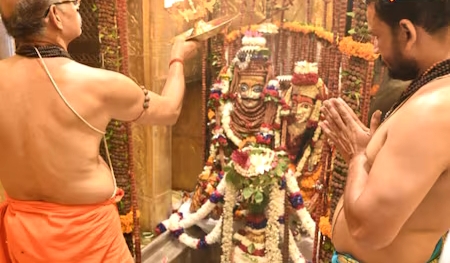
The Significance of Sawan and the Mondays
The month of Sawan, which typically falls between July and August, is dedicated to Lord Shiva. Devotees believe that worshiping Lord Shiva during Sawan brings immense blessings and helps in the fulfillment of desires. Each Monday of Sawan, known as "Sawan Somvar," holds special significance, as it is considered the most auspicious day to offer prayers to Lord Shiva.
Throughout the month, Lord Shiva is worshipped with great devotion, and special rituals are performed in temples across the country. However, the Kashi Vishwanath Temple, being one of the 12 Jyotirlingas, holds a unique place in the hearts of devotees. The temple witnesses a massive influx of devotees, not just from India but from around the world, who come to offer their prayers and participate in the rituals.
The Divine Rudraksha Adornment of Baba Vishwanath
On the fourth Monday of Sawan, the Kashi Vishwanath Temple witnessed an extraordinary event – the Rudraksha adornment of Baba Vishwanath. Rudraksha, which are sacred beads associated with Lord Shiva, hold immense spiritual significance. According to Hindu mythology, Rudraksha beads are believed to have been formed from the tears of Lord Shiva. These beads are considered to be powerful and are believed to bring peace, health, and prosperity to those who wear them.
The temple was adorned with thousands of Rudraksha beads of varying sizes, creating a mesmerizing sight for all who were present. The main deity of the temple, Lord Shiva, along with the idol of Goddess Parvati, was beautifully decorated with garlands made from these sacred beads. The Rudraksha beads were carefully strung together to create intricate patterns, which were then draped over the deities, enhancing their divine aura.
The Shivalinga, which is the central representation of Lord Shiva in the temple, was also adorned with Rudraksha garlands. The beads were arranged in such a way that they covered the Shivalinga entirely, making it a truly awe-inspiring sight. The devotees who witnessed this adornment were left spellbound by the beauty and the spiritual energy that emanated from the temple.
The Temple Complex: A Visual Feast
The Rudraksha adornment was not limited to the deities alone; the entire temple complex was decorated with these sacred beads. The walls of the temple were adorned with garlands of Rudraksha and fresh flowers, creating a serene and divine atmosphere. The combination of the Rudraksha beads and the vibrant flowers added to the spiritual ambiance of the temple, making it a perfect place for meditation and worship.
During the Shringar Aarti, which is a special ritual performed to honor the deities, the temple was illuminated with oil lamps and candles, casting a golden glow over the Rudraksha-adorned deities. The sight of the temple, bathed in the soft light of the lamps, with the Rudraksha garlands gently swaying in the breeze, was nothing short of magical. The devotees who were present during the Aarti were deeply moved by the divine atmosphere and felt an overwhelming sense of peace and devotion.
The Rituals: A Blend of Tradition and Devotion
The Rudraksha adornment of Baba Vishwanath was followed by the ritualistic Aarti, which is a significant aspect of the worship in the Kashi Vishwanath Temple. The Aarti is a devotional song that is sung in praise of Lord Shiva, accompanied by the ringing of bells, the blowing of conch shells, and the lighting of oil lamps.
The Aarti began with the priests chanting hymns from the Vedas, invoking the blessings of Lord Shiva. As the Aarti progressed, the devotees joined in, singing the praises of Lord Shiva with great fervor. The atmosphere was charged with devotion, as the sound of the bells and the chanting of the hymns echoed through the temple complex.
The Aarti was followed by the offering of Prasad, which included the sacred Rudraksha beads used in the adornment. These beads were distributed among the devotees as a token of Lord Shiva's blessings. The devotees cherished these beads, believing that they would bring them peace, prosperity, and protection from negative energies.
The Significance of Rudraksha in Hinduism
Rudraksha holds a special place in Hinduism and is often worn by devotees of Lord Shiva. These sacred beads are believed to possess mystical and healing properties. According to ancient Hindu texts, Rudraksha beads can help in controlling stress, regulating blood pressure, and bringing mental clarity. The beads are also believed to ward off negative energies and protect the wearer from harm.
There are different types of Rudraksha beads, each with a specific number of faces, known as "mukhi." The most common Rudraksha bead is the five-faced (Panchmukhi) Rudraksha, which is believed to symbolize the five elements (earth, water, fire, air, and ether) and the five forms of Lord Shiva. The seven-faced (Saptamukhi) Rudraksha is associated with Goddess Lakshmi and is believed to bring wealth and prosperity.
In the Kashi Vishwanath Temple, the Rudraksha beads used for the adornment were of various types, including the Panchmukhi and Saptamukhi Rudraksha. The temple authorities mentioned that these beads were carefully selected for their spiritual significance and were blessed by the priests before being used for the adornment.
Virtual Darshan: Experience the Divine from Home
For those who were unable to visit the Kashi Vishwanath Temple in person, the temple authorities made arrangements for a virtual darshan (viewing) of the Rudraksha adornment. With the advent of technology, devotees can now experience the divine from the comfort of their homes. The virtual darshan was broadcast live on various social media platforms and the official website of the Kashi Vishwanath Temple, allowing devotees from across the globe to participate in the rituals and seek the blessings of Baba Vishwanath.
The virtual darshan provided a 360-degree view of the temple complex, showcasing the beautifully adorned deities, the temple's architecture, and the rituals being performed by the priests. The devotees who participated in the virtual darshan expressed their gratitude to the temple authorities for making it possible for them to be a part of the Sawan celebrations, even from afar.
The virtual darshan also included a live feed of the Shringar Aarti, allowing devotees to witness the divine rituals in real-time. The experience was enhanced with devotional music and commentary, providing insights into the significance of the Rudraksha adornment and the rituals being performed. The virtual darshan proved to be a boon for those who could not make the journey to Varanasi, as it allowed them to connect with the divine and participate in the spiritual festivities.
The Legacy of Kashi Vishwanath
The Kashi Vishwanath Temple is not just a place of worship; it is a symbol of the rich cultural and spiritual heritage of India. The temple's history dates back thousands of years, and it has been mentioned in various ancient texts, including the Puranas and the Mahabharata. The temple has undergone several renovations and reconstructions over the centuries, with the most recent one being carried out by the Maratha ruler, Maharani Ahilyabai Holkar, in the 18th century.
The temple's significance goes beyond its architectural grandeur; it is a place where devotees experience a deep connection with the divine. The rituals, the chants, and the sacred atmosphere of the temple have a profound impact on those who visit it. The Kashi Vishwanath Temple is considered to be a gateway to Moksha (liberation), and it is believed that a visit to this temple can free one from the cycle of birth and death.
Over the years, the temple has attracted countless devotees, saints, and scholars, all of whom have contributed to its rich legacy. The temple's rituals, including the daily Aarti, the Rudra Abhishek (a special prayer dedicated to Lord Shiva), and the Sawan celebrations, have become an integral part of the spiritual fabric of Varanasi.
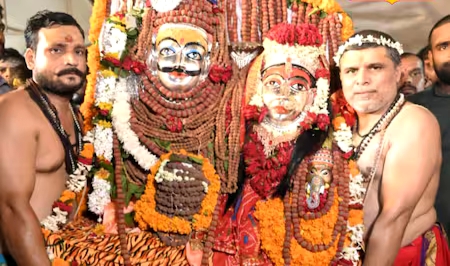
The Spiritual Significance of Varanasi
Varanasi, also known as Kashi or Benares, is one of the oldest cities in the world and is often referred to as the "City of Light." The city is considered to be one of the holiest places in Hinduism and is a major center of pilgrimage. Varanasi is believed to be the abode of Lord Shiva, and it is said that the city was established by the deity himself.
The city is dotted with temples, ghats (steps leading to the river), and ashrams, all of which contribute to its spiritual ambiance. The Ganges River, which flows through the city, is considered to be sacred, and a dip in its waters is believed to purify the soul. The ghats of Varanasi are a hub of spiritual activities, with devotees performing rituals, offering prayers, and seeking blessings from the river goddess, Ganga.






